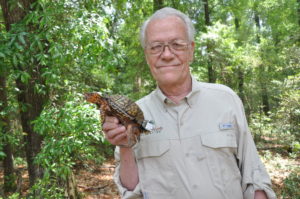Aiken a natural habitat for scientific study of box turtles
DeDe Biles
Aiken Standard
dbiles@aikenstandard.com
June 5, 2017

Aiken, S.C. – For nearly 30 years, Eastern box turtles living in Aiken Estates and Hitchcock Woods in Aiken have been generating data for scientific research.
On their shells, they wear radio transmitters, which allow Dr. Lehr Brisbin and his colleagues at the University of Georgia’s Savannah River Ecology Laboratory to keep track of where the turtles roam and where they settle down when they enter winter dormancy, which also is known as hibernation.
Brisbin has been monitoring one of the reptiles, named The Parson, since 1989.
Information about The Parson and 22 other box turtles appeared recently in a paper published in the Canadian Journal of Zoology.
Brisbin, who is a senior research ecologist emeritus at the Ecology Lab, was one of the paper’s authors. The others were Dr. Brett DeGregorio, Dr. Tracey Tuberville, Robert Kennamer and Bess Harris.
“Our questions were when do box turtles come out of winter dormancy and what causes them to come out?” Brisbin said. “Does it depend on whether they live in a backyard or the woods? Does it depend on whether they are male or female? Does it depend on whether the winter is warm or cool?”
The authors looked at facts and figures that had been compiled from 1990 to 2007. And what they discovered was a bit surprising.
“There was no extremely strong trigger that just told all the turtles to emerge at once,” said DeGregorio, who was the paper’s lead author.
Instead, the scientists found that the animals had two different emergence strategies.
“Some of them were risk-averse, so they didn’t really want to come out early in the spring and take a chance because there might be another cold snap,” said DeGregorio, who now works for the U.S. Army Corps of Engineers in Illinois. “Others were risk takers that were willing to come out as soon as they saw the first sign of spring and take advantage of the extra time to forage and find a mate.”
Brisbin likes to call the two groups “early risers” and “late risers.” He believes that their different strategies help explain why box turtles have been around for millions of years while other animals have become extinct.
“It looks like box turtles have got it all figured out,” Brisbin said. “No matter what the climate is, there is somebody that is going to make it. I would suggest that they are going to be able to survive global warming.”
In another scientific paper published in 2008, Brisbin, Kennamer and their co-authors reported that the survival rates for adult box turtles living in a suburban neighborhood and an urban forest didn’t differ greatly from those for turtles living in more natural habitats.
Brisbin, 77, is continuing to track The Parson and another box turtle named Dora locally. He also has made arrangements for several turtles to be monitored in Laurens County.
Over the years, The Parson has spent nearly all of his time in the backyard of a house in the Parsons Circle/Parsons Lane area of Aiken Estates. But in 2000, the turtle left in the fall, traveled to a patch of woods near Williams Drive and stayed there during the winter. Then, after hanging around for about a month in the spring, The Parson returned to the backyard and has remained there ever since.
Brisbin believes he knows why The Parson went on his journey.
“He (The Parson) is probably 60 to 65 years old,” Brisbin said. “If you are an animal that lives that long in one person’s backyard, all the girls around you are your daughters. It might be a good idea to go somewhere else for a while and spread your DNA.”
In the future, Brisbin hopes, the data collected from box turtles in Aiken will be used in other research efforts.
“There is still so much that can be mined from it,” he said. “I would like for people studying box turtles in other parts of the country that I know of like Maryland, Florida and Virginia to throw in with us and come up with what I call the megabuck proposal, a million-dollar grant to survey box turtles from one end of the United States to the other.”
The Ecology Lab is located at the Savannah River Site.
